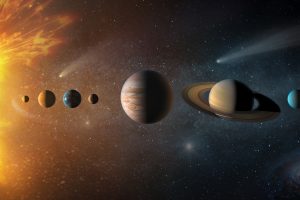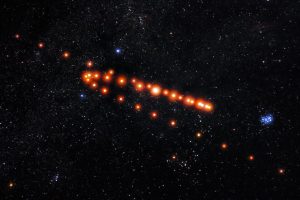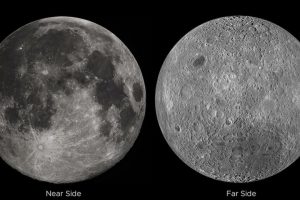
Munazza Alam, Boston USA
Throughout history, humans have gazed up at the stars and contemplated the cosmos. This fascination with the night sky has evolved over time, from looking up at the Milky Way to building instruments that magnify the distant unknown to launching telescopes into outer space. For some ancient civilizations, the awe-inspiring spectacle of the night sky pervaded social, cultural, and religious life. Today, the stars still captivate the interest of young and old alike. In this respect, astronomy ties together our past and our future. Our ancestors, looking at the same celestial bodies we do, invested them with significance and meaning. And in the the modern era, we look at the same sky, albeit with more refined instruments, and build the foundation of new technologies and new knowledge.
Astronomy is an early science, one that involves observing celestial bodies to measure their positions and properties. As our knowledge of the world around us has developed, scientists began to apply physics to understand astronomy; the field of astrophysics. While the two fields have distinct histories, the terms astronomy and astrophysics are now interchangeable since modern professional astronomers apply the principles of physics, math, and statistics to their work.
Most simply put, astronomy and astrophysics is the study of light. Particles of light called photons can be observed at many wavelengths, from low energy radio waves to high energy X-rays and gamma rays. Professional astronomers begin their training by studying radiative processes – the behaviour of light particles when they pass through gas on their journey towards observers on Earth. We can learn about a broad range of astronomical objects – including stars, planets, galaxies, and supernovae – by observing the photons they emit at different wavelengths. The tools astronomers use to obtain these observations include ground-based telescopes the size of a school bus to space-borne telescopes.
However, before we delve into where the study of astronomy is taking us, we must begin with what that study has already given us. Various civilizations around the world have contributed to our understanding of the cosmos. In 1800 BCE, the Babylonians maintained detailed documents on the movements of the celestial bodies, while the ancient Indian astronomer Aryabhatiya assumed that planets and the moon shine reflected light from the sun. The Greeks, known as the fathers of ancient astronomy, calculated the circumference of the Earth and postulated its spherical shape. In ancient Egypt, observations of the celestial bodies were used to map out where the pyramids were to be built and to predict the flooding of the Nile River. The ancient Chinese astronomer Shi Shen created The Star Catalogue of Shi, one of the oldest and most detailed catalogues of stars. In Islamic Persia, the astronomer Azophi described the constellations and our neighbouring Andromeda Galaxy in detail in The Book of Fixed Stars, while Abu Mahmud Hamid ibn Khidr al-Khujandi made the first sextant to measure the axial tilt of the Earth.
Having observed the stars in the sky and the planets in our own solar system, one question naturally arises, ‘Are we alone?’ In the third century BCE, the Greek philosopher Epicurus wrote, ‘There are infinite worlds both like and unlike ours…’ In 13th century China, the sage Teng Mu professed, ‘Outer space is like a kingdom and our Earth and sky are like no more than a single person in that kingdom.’, and Italian philosopher and astronomer Bruno further posited the existence of planets beyond the solar system in his 1584 work, De L’infinito Universo E Mondi. He wrote, ‘There are countless suns and countless Earths all rotating around their suns in exactly the same way as the planets of our system…the countless worlds are no worse and no less inhabited than our Earth.’ Remarkably, these claims purporting the existence of numerous planets throughout the universe were confirmed just two decades ago with the discovery of the first exoplanet, or planet outside of the solar system.
The notion of extraterrestrial life is another theme that crossed cultures and persisted throughout the centuries. For example, the 15th century Muslim astronomer, Ulugh Beg, noted that in the Holy Qur’an it says, ‘And among His Signs is the creation of the heavens and the earth, and of whatever living creatures He has spread forth in both.'[1] While we know with statistical confidence today that there are more planets in the universe than there are stars, determining if one of these planets hosts life is still out of reach. we will only begin to be able to address this question of planet habitability with upcoming facilities such as the James Webber Space Telescope (JWST), the successor to the Hubble Telescope that is set to launch in 2021. With JWST, we will be able to obtain data precise enough to characterize the atmospheres of smaller, Earth-like exoplanets to infer if the can host extraterrestrial lifeforms. Thus, modern advancements in technology will get us closer to answering a question we’ve been asking for hundreds of years.
In addition to providing answers to age old questions, advancements in astronomy are also leading us in exciting new directions. In 2015, astronomers detected gravitational waves for the first time. These ripples in the fabric of space-time are emitted when massive objects, such as black holes, merge and release energy. Gravitational waves were theorized to exist by Albert Einstein exactly one hundred years prior to the first observation. This discovery, which was awarded the Nobel Prize in physics in 2017, marked the beginning of a new era in astronomy in which we can observe and understand some of the most mysterious astronomical phenomena through a medium other than light.
Just four years ago, a planet slightly larger than Earth was discovered orbiting Proxima Centauri, the closest star to Earth. This planet is close enough to Earth that it is feasible to build a spacecraft, send it to this planet, and have it return to us within our lifetimes. Some groups, such as the Breakthrough Starshot Initiative, have even come up with creative and cost-effective designs for a spacecraft to potentially send to our nearest neighbouring planet.
Furthermore, the 2019 Nobel Prize in physics was jointly awarded to Jim Peebles from Princeton University for his work in advancing cosmological theory and to Michel Mayor and Didier Queloz at the Geneva Observatory for the discovery of the first exoplanet orbiting a sun-like star. The discovery of Mayor and Queloz is notable in that it did not require a high-tech or novel instrument; rather, it was made using a modestly sized telescope at the Haute Provence Observatory in the south of France.
Our understanding of the cosmos has vastly changed over the past thousand years, but the core goal of these queries has remained the same; to contextualize human existence within the temporal and spatial expanses of the universe. This desire is driven by human curiosity and awe. As the philosopher Plato wrote, ‘Astronomy compels the soul to look upwards and leads us from this world to another.’
Endnotes
- The Holy Qur’an, 42:30.
About the Author: Munazza Alam is a PhD student in the Department of Astronomy at Harvard University, a National Geographic Young Explorer, and a National Science Foundation Graduate Research Fellow.




Add Comment